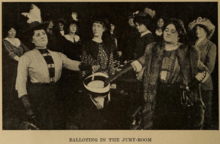Alma Webster Hall Powell
Powell toured America and Europe as a primadonna soprano, using her breaks from her singing career to carry out philanthropic work and activism, as well as to pursue higher education in a variety of fields, including law, music, and political science.
She was singing contralto at a "leading church"; Judson, the organist and a piano manufacturer, recognized her talent and began working with her to develop it.
[8] In 1922, Variety reported that Powell sued for $75,000 in damages and was awarded $13,000 from the New York Central Railroad, for injuries received in a train wreck on July 2, 1920.
[4] According to The National Cyclopædia of American Biography, after her 1900 graduation from New York University, Powell reentered the operatic field, singing at the Stadt Theatre, Breslau, Germany, in The Huguenots, Martha, The Barber of Seville, Lakmé, Faust, Don Giovanni, La Traviata, Lucia di Lammermoore, and repeating her former successes at the Royal Opera House in Berlin.
[10] Powell and Pirani then toured throughout Russia, France, Germany, Italy, Austria, Hungary, and England, before returning to the United States.
[12] In 1906, in conjunction with her husband, she opened the Powell Musical Institute in Brooklyn, teaching voice culture, piano playing, harmony, composition, and languages.
[4] Moving Picture News reported that Powell would perform a concert tour of Europe in August 1911 and sing a grand opera in Berlin.
[18] Motion Picture Story Magazine published another photoplay by Powell in March 1912, titled "The First Woman Jury in America.
She felt that moving pictures would be a good medium for reproducing "grand opera stories" and "the great dramas," as long as care was taken to accurately adapt them to film.
She successfully raised large sums for aid of the poor by her voice, and gave free instruction to working girls in music, languages and general science.
[23] Powell patented several innovations related to ladies' garments,[24] including a method by which raincoats or other outerwear could be detached at the shoulders and fastened on an underskirt as a form of drapery.
[25][26] In a spread mocking "Cubist fashion" published in the Chicago Daily Tribune on April 6, 1913, Powell was illustrated alongside suffragists Carrie Chapman Catt and Rosalie Jones, opera singers Geraldine Farrar and Mary Garden, actresses Billie Burke, Alla Nazimova, and Sarah Bernhardt, novelist Edith Wharton, and dancer Gaby Deslys.
Published in the Chicago Tribune while the cubist canvases [of the Armory Show] were on display at the Art Institute, well-known suffragists and celebrities were shown together wearing the recognizable colorful, geometric, and angular gowns.



